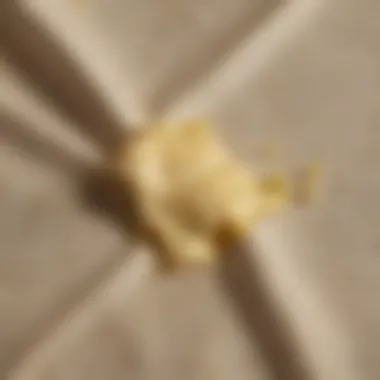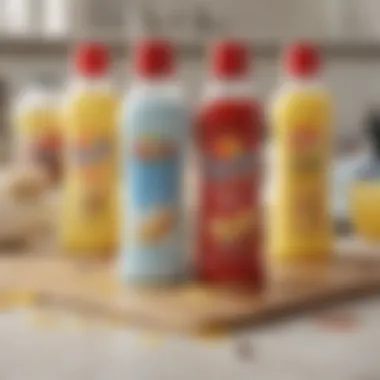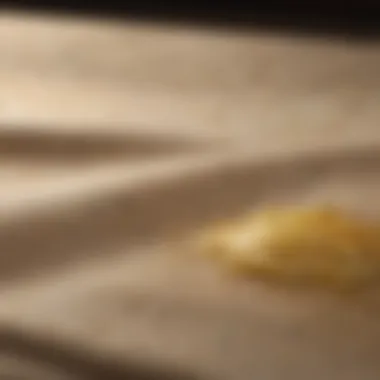Mastering the Art of Removing Dried Butter Stains


Intro
Dried butter stains on clothing are an annoying challenge for many. These stains can occur from cooking mishaps, accidental spills, or even during a casual meal. The greasy nature of butter makes removing such stains a tedious task. However, understanding effective methods can significantly ease the process.
In this article, we will explore various strategies for eliminating dried butter stains. Focusing on both household remedies and commercial products can provide options for different situations.
By the end, you will have a thorough understanding of techniques to restore your garments. Whether it’s a favorite shirt or a beloved pair of trousers, no one wants to see them marred by stubborn stains. Let's dive into the details.
Foreword to Butter Stains
Butter stains on clothing can be a hassle for many individuals. Understanding the nature of these stains is crucial for effective removal. Butter is primarily made up of fats, and these fats can penetrate the fabric fibers, leading to long-lasting stains if not treated properly.
When butter spills occur, the importance of addressing them quickly cannot be overstated. The longer a stain sits, the more difficult it becomes to eliminate. Knowing how butter interacts with different types of fabrics can aid in selecting the best cleaning methods.
Several considerations come into play in removing butter stains. First, the type of fabric will influence the cleaning approach. Delicate fabrics like silk may require more careful treatment compared to sturdy cottons. Additionally, awareness of the specific properties of butter can lead to smarter stain removal tactics.
In summary, grasping the essentials about butter stains lays the foundation for further exploration of removal techniques. Readers should feel empowered by the knowledge of how to tackle these common stains effectively.
Understanding the Composition of Butter
In tackling the issue of butter stains, understanding the composition of butter is essential. This knowledge aids in identifying the components that contribute to the staining process and informs effective removal strategies. Butter is primarily made up of fat, which is why its stains can be particularly stubborn. Recognizing the various components of butter will help readers choose appropriate methods for stain removal.
Butter consists of fats, oils, and emulsifiers. The fats found in butter are predominantly saturated fats, which lend a rich texture and flavor. Additionally, its oil content can vary depending on the type of butter used. Emulsifiers in butter help bind the fats and water together, creating a creamy consistency. When butter is spilled on fabric, these components can penetrate the fibers, making them difficult to remove.
Understanding these elements is not merely academic; it guides practical approaches to stain removal. For instance, techniques using dish soap are effective because they can break down fats. Similarly, the type of fabric affected by the stain can determine the best approach for treatment. By grasping the particularities of butter's composition, readers can better navigate the complexities of stain removal.
Fats, Oils, and Emulsifiers
Fats make up the primary ingredient in butter. The presence of saturated fats means that these stains can be oily and greasy. When fats and oils in butter mix with fabric, they can penetrate fibers deeply and become adhered to them. This can create long-lasting stains if not treated correctly. The emulsifiers in butter also play a role in this process, as they facilitate the integration of oil into the fabric, complicating removal efforts.
To effectively combat these issues, it is important to use cleaning agents that target fats. Products with strong surfactants can break the bonds between fat molecules and the fabric, making it easier to lift the stain. Readers should look for cleaning solutions that are specifically designed to tackle greasy stains in garments.
How Butter Stains Set in Fabric
When butter is spilled on clothing, it doesn't just rest on the surface; it seeps into the fabric. This penetration occurs due to the oily nature of butter's composition. Tiny molecules of fat can make their way into the fibers, creating a binding effect that is not easily released. As time goes by, the heat from the body can further set the stain, making it more challenging to remove.
Different fabrics react differently to stains. Natural fibers like cotton may absorb stains more readily compared to synthetic fibers. Wool and silk, while luxurious, can retain butter stains and may require special attention during cleaning. The nature of the stain changes as it dries, with oils setting in and making them more persistent.
In summary, having a clear understanding of the composition of butter and how its stains interact with fabric is critical for effective stain management. This knowledge lays the groundwork for identifying suitable removal solutions and can help save cherished clothing from irreparable damage.
Identifying the Fabric Type
Knowing the fabric type is crucial when dealing with dried butter stains. Different fabrics have unique properties, which influence how they absorb stains and how effectively they can be cleaned. If the wrong method or cleaning agent is applied to a particular fabric, it could lead to damage. Thus, identifying the fabric not only aids in selecting the correct treatment but also helps preserve the garment's integrity.
Common Fabrics and Their Properties


Fabric can be categorized into various types, and understanding each can help in stain removal. Here are some common fabrics and their key properties:
- Cotton: This is a highly absorbent fabric. It can usually withstand higher temperatures in cleaning but may shrink if not treated properly. Dried butter stains on cotton can often be removed with hot water and soap.
- Polyester: Polyester is less absorbent than cotton. This can be advantageous, as it does not soak up oils as quickly. However, this characteristic also means that stains may sit on the surface longer. Polyester typically requires a specific stain remover when dealing with oily stains.
- Wool: Wool is delicate and requires gentle treatment. Hot water can damage the fabric, leading to shrinkage or distortion. When addressing butter stains on wool, it's best to use a specialized wool cleaner or a mild detergent applied carefully.
- Silk: Silk is luxurious but very sensitive. It can be damaged easily by heat or harsh chemicals. Use a gentle approach such as cold water and a mild soap for removing butter stains from silk.
- Denim: Denim is durable and can handle vigorous washing. However, it may require special stain treatments for oil-based stains. A paste solution can be very effective on denim without causing damage.
Assessing Fabric Care Labels
Fabric care labels are often overlooked but are instrumental in understanding how to treat specific garments. These labels provide essential information regarding cleaning methods, acceptable temperatures, and whether the item is machine washable.
- Washing Symbols: Look for symbols indicating washing temperatures. A fragile fabric may not tolerate high heat, while cotton might.
- Drying Symbols: Some fabrics should not be put in a dryer, as it could lead to shrinkage or distortion. These labels clarify how to properly dry the items.
- Ironing Symbols: This shows if it is safe to iron the fabric and at what temperature.
Important: Always adhere to the manufacturer's instructions on the care label before attempting any stain removal process. This can save you from damaging valuable pieces.
By carefully assessing the fabric type and following care label instructions, one can effectively plan the best course of action for removing dried butter stains, ensuring the preservation and longevity of clothing.
Initial Steps for Treatment
Addressing dried butter stains on your clothing requires careful initial actions. The treatment methods can vary significantly depending on how quickly you act and how effectively you manage the stain in the early stages. Recognizing the importance of fast action can make a substantive difference in the overall stain removal process. If you're thorough in the pre-treatment stages, it increases your likelihood of successfully removing the stain.
Act Quickly
Time is of the essence when dealing with dried butter stains. The sooner you attend to the stain, the less ingrained it becomes in the fabric fibers. If you delay, the fats in the butter can bond with the fabric, leading to a more challenging removal process. Rapid action not only minimizes the stain but also prevents any potential discoloration of the fabric.
To take effective action, immediately gather the necessary tools and products for treating dry stains. This can include knives for scraping, paper towels for blotting, or any cleaning agents you might consider using. Being prepared can streamline your response and bolster your chances for success.
Removing Excess Butter
Once you have recognized the stain, it is important to begin by removing any excess butter before applying cleaning solutions. This initial step helps to reduce the amount of stain that needs treatment, making the overall cleaning process easier.
Gently Scrape with a Knife
Using a blunt knife is one effective method for removing excess butter. This strategy involves lightly scraping the surface of the fabric to lift and remove as much of the butter as possible. The key benefit of this method is that it minimizes the risk of pushing the butter deeper into the fabric fibers. For this reason, using a blunt instrument, rather than a sharp one, is advisable to avoid causing any damage to the garment.
While this technique is often a popular choice, care must be taken to ensure that the scraping is gentle. The unique feature of scraping is that it allows for immediate removal of residue before it can set in further. However, one disadvantage is that improper scraping can lead to fraying or pulling of the fabric, necessitating a delicate touch.
Use a Paper Towel
Another effective method for removing excess butter is the use of a paper towel. This approach involves pressing a paper towel against the stained area to absorb the butter. The paper towel is very beneficial for quickly lifting more of the butter without spreading it further. Simply place the towel over the area and gently press down—avoid rubbing as this could push the butter deeper into the fabric.
This method is particularly advantageous in that it is quick, straightforward, and does not require any tools. However, it is important to note that this technique may not remove all of the butter, sometimes requiring further action afterwards. Despite this potential limitation, utilizing a paper towel is often a practical first step before moving on to deeper cleaning methods.
Homemade Solutions for Stain Removal
Homemade solutions for removing dried butter stains are an essential part of any stain treatment strategy. These methods are often accessible, cost-effective, and effective on various fabric types. In addition, they rarely involve harsh chemicals, making them safer for both the user and the environment. Homemade solutions empower individuals to address stains promptly without needing specialty products.
Using Dish Soap
Applying the Solution


Dish soap serves a vital role in removing butter stains. Its efficacy relies on its surfactants, which help break down grease. To apply this solution, start by dampening the stained area with water. After this, directly apply a few drops of dish soap onto the stain. Gently work the soap into the fabric using your fingers or a soft cloth. This method is popular because it is easy and requires minimal effort and materials. The convenience of having dish soap readily available in most kitchens adds to its appeal. However, it's crucial to ensure that the soap is thoroughly rinsed to avoid any residue.
Soaking Process
The soaking process amplifies the effectiveness of dish soap. After applying the soap, letting the item soak in warm water for approximately 15 to 30 minutes can enhance its stain-fighting properties. This approach allows the soap to penetrate deeper into the fibers, loosening the butter's grip on the fabric. The soaking technique is widely recommended because it can help lift stubborn stains. For this process, ensure the water is not too hot to prevent fabric damage. A potential downside is that prolonged soaking may lead to fading in some colored fabrics.
Baking Soda Paste
Creating the Paste
Baking soda is another effective option for treating butter stains. To create a paste, combine baking soda with a small amount of water until a thick consistency forms. This paste can then be applied directly to the stain. The unique characteristic of this method is its gentle abrasive nature, which allows it to lift the stain without damaging the fabric. Baking soda is easily accessible and inexpensive, which adds to its benefits. However, it may require more effort for complete stain removal compared to other methods.
Scrubbing the Stain
Scrubbing the stain with the baking soda paste helps in further lifting the butter residue. Using a soft cloth or a soft-bristled brush, gently rub the paste into the fabric. This treatment is especially effective for thicker stains that need extra attention. The scrubbing action not only aids in the removal of the stain but also incorporates the absorbent qualities of the baking soda. Nevertheless, caution is necessary to avoid excessive force that could damage delicate fabrics.
Cornstarch or Talcum Powder
Application Technique
Cornstarch or talcum powder can be effective in absorbing grease from butter stains. To use, simply sprinkle a generous amount directly onto the stained area. Allow it to sit for at least 30 minutes. This technique works well to draw the oils from the butter into the powder. The absorbent capacity of cornstarch or talcum powder makes it an attractive option for this purpose. However, it is important to note that these powders may not be suitable for all fabric types, as they could potentially cause discoloration.
Timing for Effectiveness
Timing is critical when using cornstarch or talcum powder. Leaving the powder on longer increases its effectiveness. The longer the absorption, the more oil can be lifted from the fabric. Keeping this in mind can lead to better results in stain removal. A downside to this method is that it may leave a powdery residue, which may require additional cleaning steps afterward.
Commercial Stain Removers
Commercial stain removers play a significant role in effectively dealing with dried butter stains on clothing. While homemade solutions can be quite effective, commercial products often offer a concentrated formula designed specifically to tackle grease-based stains. These products come with the advantage of being tested for various fabric types and can provide quicker results, especially when dealing with stubborn stains that have set in over time.
When selecting a commercial stain remover, it is essential to consider the type of fabric being treated and the severity of the stain. Some formulas may be too harsh for delicate fabrics, while others are versatile enough for various materials. The convenience of having a ready-to-use solution can save time, especially for those who may not have access to DIY ingredients. Furthermore, these products often come with specific instructions that maximize their efficiency in removing tough stains, making them a practical choice for busy individuals.
Active Ingredients to Look For
When shopping for a commercial stain remover, it's crucial to be aware of the active ingredients that contribute to its effectiveness. Common ingredients include:
- Surfactants: These compounds break down grease and oils, making it easier to lift stains from fabrics.
- Enzymes: Protease and lipase enzymes target protein and fat stains, respectively. They effectively break down components of butter that might otherwise cling to the fabric.
- Solvents: Alcohol or other solvents can dissolve the oil in butter, helping to release the stain during washing.
- Bleaching agents: Oxygen-based whiteners can remove discoloration from light fabrics, though caution should be exercised to avoid damage to colors.
It is advisable to read labels carefully to understand whether a stain remover contains these ingredients and how they might interact with your specific clothing items. Using a product with the right active ingredients can make all the difference when trying to remove stubborn butter stains.
Application Instructions
Proper application of a commercial stain remover is crucial for achieving optimal results. Here are some general steps to follow:
- Read the Label: Always start by reading the instructions on the product label. Different brands may have unique application recommendations.
- Pre-Treat the Stain: Apply the stain remover directly to the butter stain, ensuring that the product saturates the area. For better absorption, gently rub it into the fabric.
- Let it Sit: Allow the stain remover to act on the stain for the recommended time, usually between 5 to 15 minutes, depending on the product.
- Wash as Usual: After the treatment period, wash the garment in accordance with the care instructions on the label. Use the hottest water suitable for the fabric type to help remove any remaining stain.
- Check Before Drying: Before tossing the garment in the dryer, check to ensure that the stain is completely gone. Heat can set the stain, making it nearly impossible to remove.


By following these instructions, you can effectively utilize commercial stain removers to eliminate dried butter stains, protecting your favorite garments from lasting damage.
Washing and Final Care
Washing and final care play a crucial role in effectively managing dried butter stains. These steps not only determine the success of previous stain-removal efforts but also ensure that the fabric retains its integrity and color after treatment. Proper washing techniques and care can eliminate residual butter and prevent further set-in stains, making these processes critical components of any successful stain removal strategy.
Selecting the Appropriate Wash Cycle
Choosing the right wash cycle is essential to enhance the stain removal process. Different fabrics require different care to optimize cleaning without causing damage. Here are key considerations:
- Fabric Type: Always consider the fabric content before selecting the cycle. For example, delicate fabrics like silk or chiffon should be washed on a gentle cycle. In contrast, cotton or sturdy fabrics can handle a regular cycle.
- Temperature Settings: Hot water does an excellent job at breaking down oils. However, it is not suitable for all fabrics. Check the garment's care label to determine the maximum temperature it can withstand. Additionally, warm water is often a safe middle ground that can effectively dissolve butter without risking fabric damage.
- Cycle Length: A longer wash cycle may be more beneficial, especially when dealing with persistent stains. Extended agitation allows cleaning solutions to penetrate the fabric and effectively lift the butter out. However, always prioritize the garment's care instructions.
Using the right settings increases the likelihood of completely removing butter stains while preserving the garment's structure and appearance.
Drying Considerations
After washing, the drying process is equally important.
- Avoid Heat Drying: It is essential to avoid placing garments with residual butter stains into a dryer. Heat can set the stain, making it more difficult to remove later. Always allow items to air dry if you are unsure about the success of the washing process.
- Check Before Drying: Inspect the clothing after the washing cycle to see if the stain has completely lifted. If the stain remains, repeat the washing or pre-treatment steps. Drying with the stain still present can be counterproductive.
- Sunlight Exposure: For some fabrics, natural sunlight can aid in stain removal due to its bleaching properties. However, colors can fade, so exercise caution. Choose shaded or indirect sunlight for drying colored items.
Maintaining attentiveness during the drying phase directly impacts the final appearance of the garment. Ensuring that the butter stain is fully addressed before further drying steps will preserve the longevity and look of the clothing.
Preventive Measures
Preventive measures are essential when it comes to managing butter stains on clothing. Addressing potential stains before they happen can save you time and energy later on. The better you choose your clothing and apply treatments, the less likely you are to deal with the hassle of stubborn stains.
Choosing the Right Clothing
Selecting clothing wisely can significantly lessen the chance of butter stains setting in. Fabrics with tighter weaves tend to resist stains more effectively than loosely woven materials. For example, polyester blends are known for their durability and stain resistance compared to cotton. Additionally, darker colors can disguise accidental spills more effectively than lighter shades. It's also advisable to avoid lightweight fabrics like silk or linen when eating messy foods, as they often absorb stains more quickly.
- Prioritize Synthetic Fibers: They are often treated for water and stain resistance.
- Go for Structured Fabrics: Sturdier materials are less likely to stain than delicate ones.
- Consider Color Choices: Dark colors can camoflage stains better than light colors.
Ultimately, thinking ahead about your clothing choices can make a big difference.
Stain Resistant Treatments
Applying stain-resistant treatments to garments is another effective preventive measure. These treatments create a barrier that helps prevent stains from setting in. Many brands offer commercially available sprays designed for use on a variety of fabrics.
- Look for Reliable Products: Brands like Scotchgard offer easy-to-use options.
- Proper Application: Always follow the manufacturer's instructions for best results to ensure the treatment is effective.
- Regular Maintenance: Reapply the treatment as needed, especially after washing.
By being selective about clothing and utilizing stain-resistant treatments, you can greatly decrease the likelihood of butter stains ruining your garments. This proactive approach can make maintaining your wardrobe far easier.
Closure
Removing dried butter stains from clothing is not just a simple task; it is more about preserving the fabric's integrity and maintaining the quality of your garments. This article has explored various methods and approaches for effective stain removal, emphasizing both household techniques and commercial solutions. Understanding the composition of butter, the right method of stain removal, and the properties of fabric are crucial for achieving satisfactory results.
The key takeaway is that acting quickly and utilizing the appropriate solutions can make a significant difference in successfully treating butter stains. Homemade solutions such as dish soap, baking soda, and cornstarch offer effective alternatives, while commercial stain removers can also provide effective results when used correctly.
Moreover, preventive measures play an important role. By selecting stain-resistant fabrics and being mindful of the application of butter, you can lessen the occurrence of future stains. This proactive attitude can save effort and time in the long run.
"Being informed and prepared is half the battle in maintaining your clothing."
In summary, the methods discussed not only address butter stains but also enhance your overall approach to garment care. When you are equipped with proper knowledge and techniques, you can approach any stain confidently, ensuring your clothing remains both spotless and suitable for various occasions.





